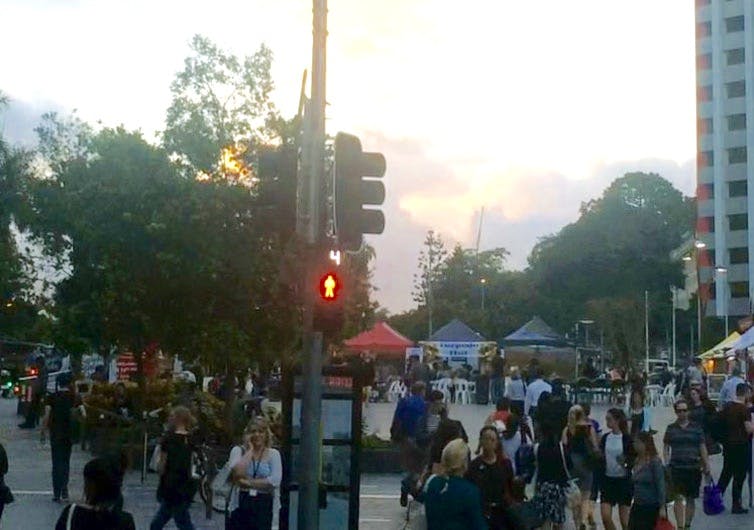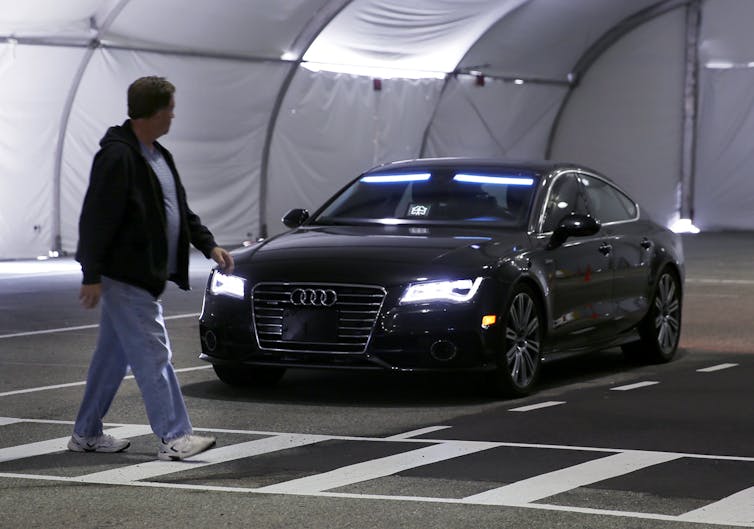One pedestrian is killed each two days on Australia’s roads, the bulk in metropolitan areas. Whereas advances in security techniques and expertise over previous a long time have enormously improved driver and passenger security, there was comparatively little new expertise to make sure the security of pedestrians. Even present improvements to enhance pedestrian security are nonetheless designed from a car-centric method.
In lots of locations strolling is considerably extra harmful than travelling by automobile, regardless of largely separated amenities and slower speeds than some other mode of journey. Worldwide, greater than 270,000 pedestrians lose their lives on roads every year – 22% of all highway site visitors deaths.
Enhancements in pedestrian security are primarily byproducts of driver-focused insurance policies comparable to random breath-testing and velocity cameras. Little doubt these scale back pedestrian fatalities, however are we relying an excessive amount of on driver behaviour when a big proportion of drivers are unwilling to vary?
Regardless of 34 years of random breath testing in New South Wales, 12% of crashes within the state’s cities contain alcohol. Pace cameras have been in use in NSW for 25 years, however 33% of crashes in cities nonetheless contain rushing.
Know-how design focus remains to be on automobiles
Despite efforts to extend strolling, Australian cities proceed to be constructed with automobiles, somewhat than pedestrians, in thoughts. Australia is trying to replace site visitors lights, which have proven little innovation since first launched within the US in 1912.
Trials of countdown timers are underway at main Sydney CBD crossings, comparable to Elizabeth Road in Sydney, and all through Brisbane. However this expertise is just exacerbating the issue. By encouraging individuals to make a “run for it” throughout an intersection, they put themselves at better danger of an accident.

Martin Tomitsch
Neither the expertise nor pedestrians are responsible for this. The difficulty is that these initiatives nonetheless take a car-centric perspective: they prioritise a fast clearing of the highway so automobiles can go.
What issues to pedestrians is how lengthy they’ve to attend till they’ll cross the highway, however their wants are typically handled as an afterthought. As city populations proceed to develop and age, it’s vital to place individuals earlier than automobiles.
Understanding individuals’s behaviour and desires is on the coronary heart of designing expertise. It’s what has led to new services which might be disrupting industries and reworking our lives – whether or not it’s reserving a resort, catching a taxi or watching TV. However the roll-out of pricey highway security techniques appears to be lagging and ignoring this necessary precept.
As a substitute, we blame individuals for texting whereas crossing roads as the reason for pedestrian fatalities, regardless of a scarcity of crash knowledge to help this. Proof from hospitals suggests speaking on a cell or listening to music is extra harmful for pedestrians.
Even then, it should be recognised that pedestrians die as a result of collisions with autos, not one another. Any security resolution should contemplate the way in which all highway customers work together with one another and infrastructure.
New sensors geared toward pedestrian security
The automobile trade is slowly taking over this problem by trialling new sensors that robotically cease the car when approaching a pedestrian.
Security techniques that concentrate on the individuals across the automobile will develop into much more necessary as we transfer nearer to a way forward for autonomous autos. Audi’s driverless idea automobile achieves this through the use of a show behind the windscreen that lets onlookers know that the automobile sees them.

Audi/www.fastcodesign.com
New sensors accumulate knowledge about circumstances and the motion of individuals and autos in cities. In 2014, Chicago introduced it was putting in 40 sensors, with plans for 1,000 over the subsequent few years. In Australia, Melbourne has been putting in and testing pedestrian-counting sensors since 2012.
On the similar time algorithms are being developed to make sense of the huge quantities of information being collected and to help cities of their decision-making and planning processes.
Nonetheless, these techniques are largely designed for metropolis and authorities authorities, as a substitute of creating knowledge obtainable to these utilizing town infrastructure. The expertise exists to extract data from these knowledge sources and transmit them in actual time to whomever and wherever it’s wanted, however has but to be utilised.
A current hackathon on the College of Sydney, held in collaboration with the NSW authorities’s Knowledge Analytics Centre, demonstrated the rising curiosity find options to pedestrian security.
The information is there, however we have to establish and take a look at options that carry a direct profit to pedestrians. For instance, it might be doable to warn drivers and/or pedestrians of an impending collision, recognising that each one individuals make errors.
We require a extra detailed examine of which digital options will make our roads and cities safer. It’s necessary to know individuals’s wants earlier than rolling out these applied sciences on a big scale – whether or not it’s countdown timers or site visitors lights embedded within the highway.

